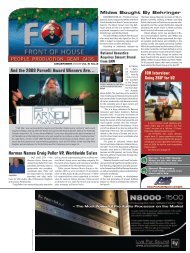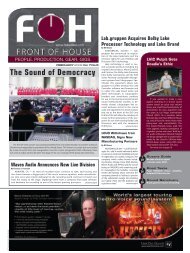You also want an ePaper? Increase the reach of your titles
YUMPU automatically turns print PDFs into web optimized ePapers that Google loves.
The classical Stravinski Auditorium rocks out in Montreux<br />
venue every year, and as new equipment becomes<br />
available, we find ways to employ it.<br />
What’s involved in the planning process?<br />
When we’re putting together the show<br />
every year, we work with our systems designer,<br />
Martin Reich, and the people from Meyer<br />
Sound to spec out the audio systems, taking<br />
into account any changes in the acoustics of the<br />
venues, the availability of new products and any<br />
feedback from previous shows. They also meet<br />
with the Digidesign people to discuss the mixing<br />
console needs and with the Shure people to<br />
talk about microphones and wireless needs.<br />
Then each venue is modeled using MAPP<br />
<strong>Online</strong> Pro to create a detailed layout of the<br />
systems, including the placement and angles of<br />
the speakers and predictions of the array coverage.<br />
Once we draw up an inventory, we source<br />
the equipment via several regional rental companies.<br />
We have long-term relationships with<br />
these partners as well; we know who’s strong in<br />
what areas and who has what inventory.<br />
Then when setup is completed on location,<br />
we bring in the SIM 3 system to fine-tune the<br />
rigs, using the Galileo for processing.<br />
What kind of challenges do the rooms present?<br />
Stravinsky Auditorium, our main venue, is<br />
always a challenge. It was designed as a classical<br />
hall, with a reverb time of several seconds, and<br />
we try to take that down to about one second.<br />
The acoustic treatment was proposed by John<br />
Meyer and was designed and implemented by<br />
the company that originally built the room’s<br />
acoustics.<br />
The sound regulations in Switzerland are<br />
also a big challenge, and we have to constantly<br />
pay close attention to our levels. The Meyer<br />
line arrays help a lot because we can achieve a<br />
very even coverage with them, and the Galileo<br />
processors, with their considerable processing<br />
power and multiple I/O, enable us to distribute<br />
the sound, time align, filter and EQ the systems<br />
neatly and efficiently.<br />
The festival has a reputation for showcasing<br />
a lot of cutting-edge equipment.<br />
Many of our partners like to showcase new<br />
products here because it offers such a wide<br />
range of music and conditions. Meyer Sound<br />
has shown a lot of their loudspeakers here, including<br />
the MILO, MICA and M’elodie arrays,<br />
and their MJF-212 monitor, which is named for<br />
the festival. Shure has debuted wireless systems<br />
and microphones here, and of course, Digidesign<br />
brought in the VENUE console when it was<br />
first introduced.<br />
How has the VENUE influenced production?<br />
The VENUE has reduced the amount of outboard<br />
gear we need, which has enabled us to<br />
reduce the overall footprint of the <strong>FOH</strong> areas.<br />
It’s also streamlined the live recording process<br />
and made it easier to link directly with the production<br />
trucks. A lot of visiting engineers really<br />
love it because they<br />
can just bring a USB<br />
drive and dump<br />
their settings, and<br />
even their personal<br />
plug-ins, into the<br />
desk, which saves a<br />
lot of setup time.<br />
You also do full<br />
video production?<br />
Both main halls<br />
are equipped for<br />
five or six camera<br />
HD shoots, with<br />
one main camera, a couple of booms and<br />
two or three on stage. We send live video,<br />
along with direct multichannel feed, to two<br />
dedicated production trucks in the basement<br />
parking area.<br />
We’ve worked with the Voyager trucks for<br />
many years, but this year, one of their trucks<br />
caught fire only two weeks before the start<br />
of the festival, so we had to make some lastminute<br />
decisions. We brought in two expanding<br />
trucks and had acoustical engineers using<br />
Meyer’s SIM 3 system and spreadsheets to design<br />
and create accurate mix rooms. We used<br />
two identical trucks so we could duplicate the<br />
arrangement precisely.<br />
The editing suites are running pretty<br />
much all day. Most of the shows are edited<br />
and archived. Eagle Vision releases them as<br />
part of the Live at Montreux series of DVDs.<br />
You were holding shows at the Casino<br />
again for several years, but you’ve<br />
stopped that this year. Why?<br />
The Casino is where the festival began<br />
and, of course, it’s been made famous by<br />
the song “Smoke on the Water.” It was nice<br />
doing shows there again from a historical<br />
perspective, but it’s about one kilometer<br />
from the Convention Centre, through<br />
some pretty crowded streets, and the logistics<br />
were pretty challenging. Claude<br />
(Nobs) usually introduces the acts on the<br />
main stages, and he had to ride on the<br />
back of the technical director’s motorcycle<br />
to get from one place to the other. It was<br />
a lot of running around for the technical<br />
staff as well.<br />
Ad info:http:// www.plsn.com/instant-info
















